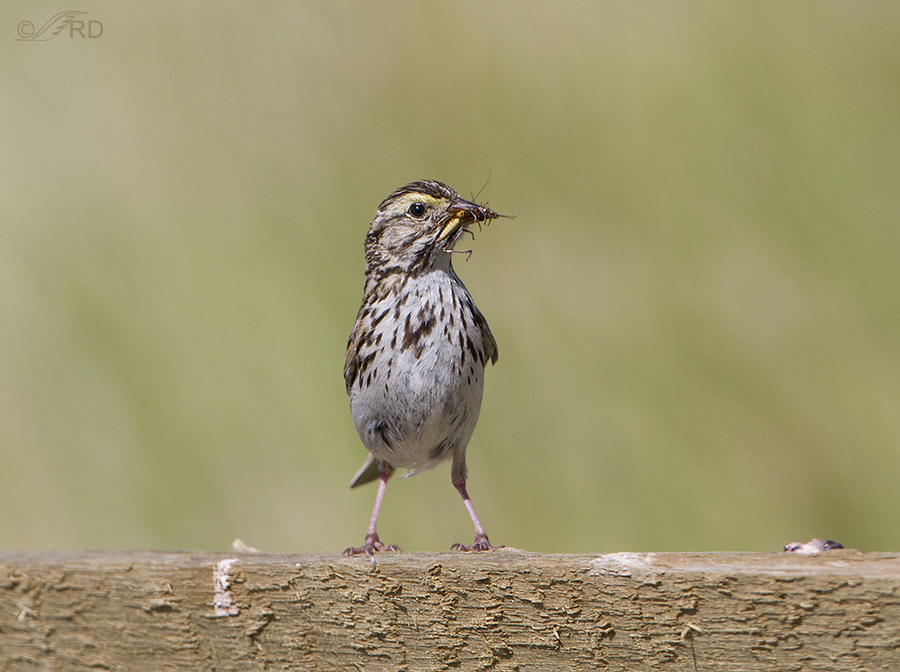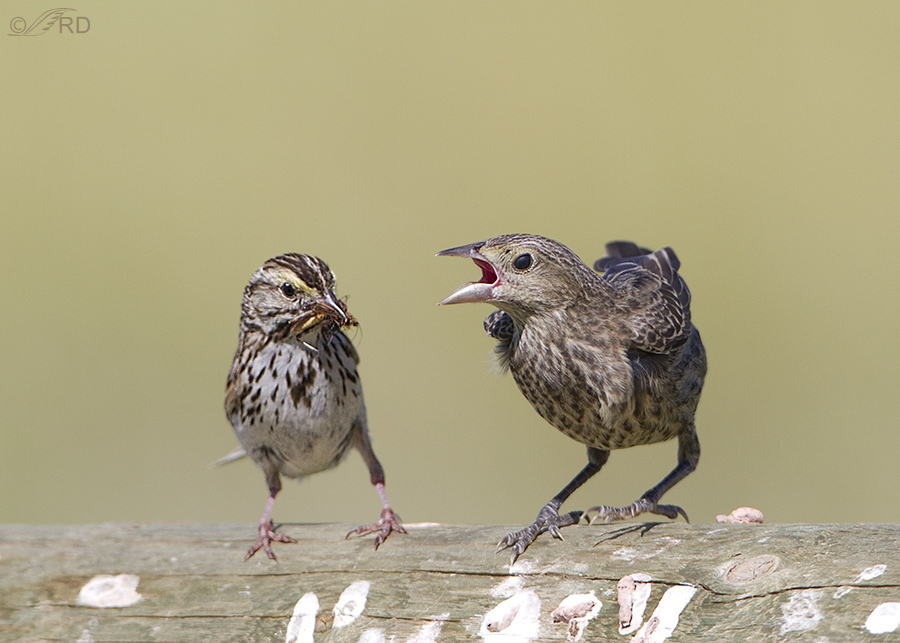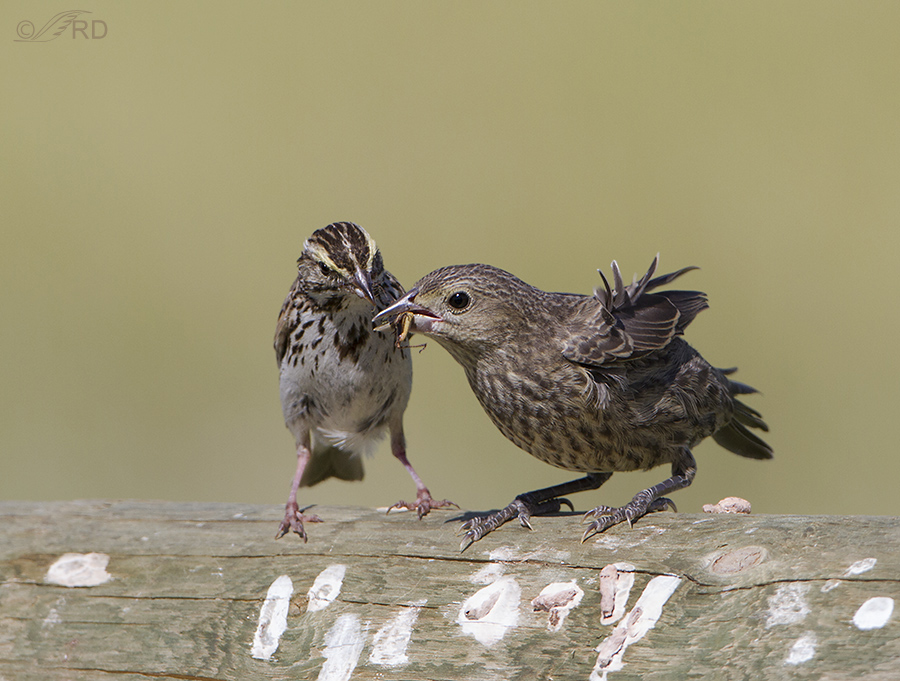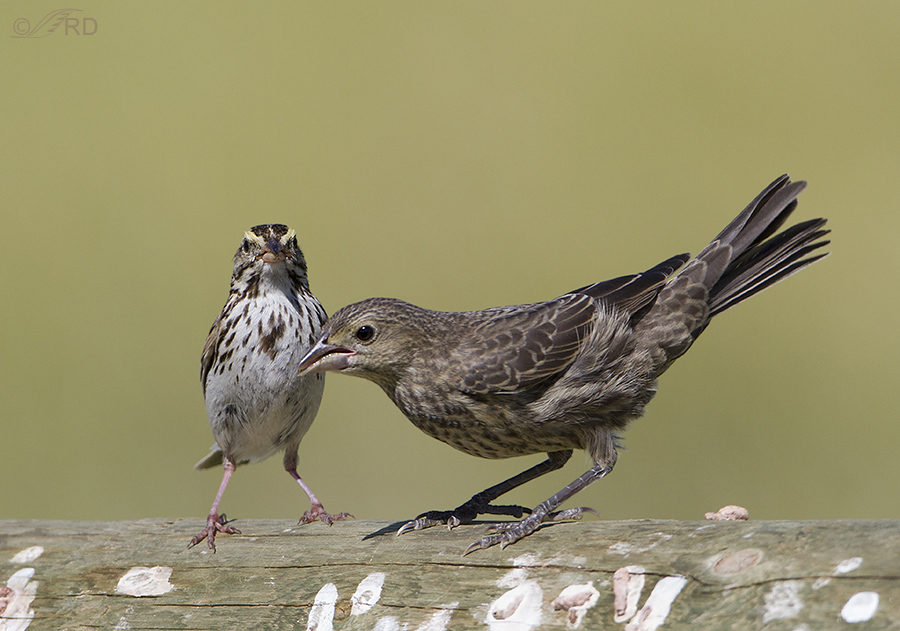Brown-headed Cowbirds are well-known for laying their eggs in the nests of other species – brood parasitism. A single cowbird female may lay up to 40 eggs in the nests of other species per season. More than 220 host species have been identified and at least 144 of those species have successfully raised the parasitic cowbird offspring. The physical size of the host species ranges from tiny 10 gram creepers to 150 gram meadowlarks.
For a variety of reasons, the young of the parasitic cowbirds are more likely to survive than are those of the host species. The breeding success of the rare Kirtland’s Warbler has been severely reduced by cowbird brood parasitism.

1/1600 f/7.1, ISO 400, 500 f/4
On our recent trip to sw Montana we found this Savannah Sparrow bringing food (insects, mostly young grasshoppers) to one of its fledglings on a fence near our campground.

1/1600 f/6.3, ISO 400, 500 f/4
But the fledgling was a cowbird and not a Savannah Sparrow. Cowbirds are more than twice the size of Savannah Sparrows by weight and that difference is obvious here.

1/1600 f/7.1, ISO 400, 500 f/4
The cowbird youngster was boisterous and rambunctious when food was brought in. I actually had the impression that the adult sparrow was a little intimidated by the size and hyperactivity of the cowbird chick and the “parent” bird didn’t stick around for long when food was delivered.
 1/1600 f/7.1, ISO 400, 500 f/4
1/1600 f/7.1, ISO 400, 500 f/4
After the chick swallowed this grasshopper the sparrow gave it another insect that is mostly inside his/her beak and can’t be seen well in this photo.

1/1600 f/7.1, ISO 400, 500 f/4
I thought this image showed best the dramatic size difference between the adult sparrow and the young cowbird.
Lots of folks despise cowbirds for the negative effects their brood parasitism has had on songbird populations. But the dramatic increase in the range of the Brown-headed Cowbird in North America is largely due to the westward expansion of human settlements which reduced forests and increased agricultural and suburban landscapes, thus allowing for the spread of the cowbird. Personally I can’t blame the bird for that and as a biologist I marvel at the evolutionary selection process that produced this amazing behavior in the first place.
Ron


The cowbirds’ behavior always fascinates me. I´ve read that some species have produced certain strategies against parasitism. Lets hope those species in trouble learn themselves. Great photos!
Ron, I can’t help but have a little laugh when I see photos of fledgling Cowbirds being fed by their miniature parents. But these photos are so wonderful, I can only look upon them in awe … of your photographic and artistic skills. Young Cowbirds were among the babies Hugh and I fed at our wildlife hospital. They were certainly aggressive in letting us know when they were hungry, but I never felt anything but empathy for them … as I do for the many species who’ve had to adapt to the massive habitat changes we’ve inflicted upon them.
Beautiful pictures — fascinating little story your images tell, too… I learned something new. Like you said — I can’t blame a bird for doing what its biology dictates!
Thank you Christina.
Another great, informative post, Ron. I love the way you get the right photos to emphasize your stories. I think I said that right. 🙂
Thank you Bob, but to be perfectly honest I’ll admit that I usually build my “stories” around the photos I get, rather than the other way around.
We are responsible for so many changes in animal habitat. Sadly off the top of my head I can’t think of a positive impact. It is fascinating – but it is also very sad. Or perhaps I am just a tree hugger with my head in the clouds. Or up my butt.
Us tree huggers need our heads in the clouds occasionally Elephant’s Child – to offset the heads of others that are always in that “other place” further south.
I find it interesting, too. And if they are so successful that they eliminate the host birds, will they learn to build nests, raise their own broods and pay the mortgage? 😉
Made me smile Tana.